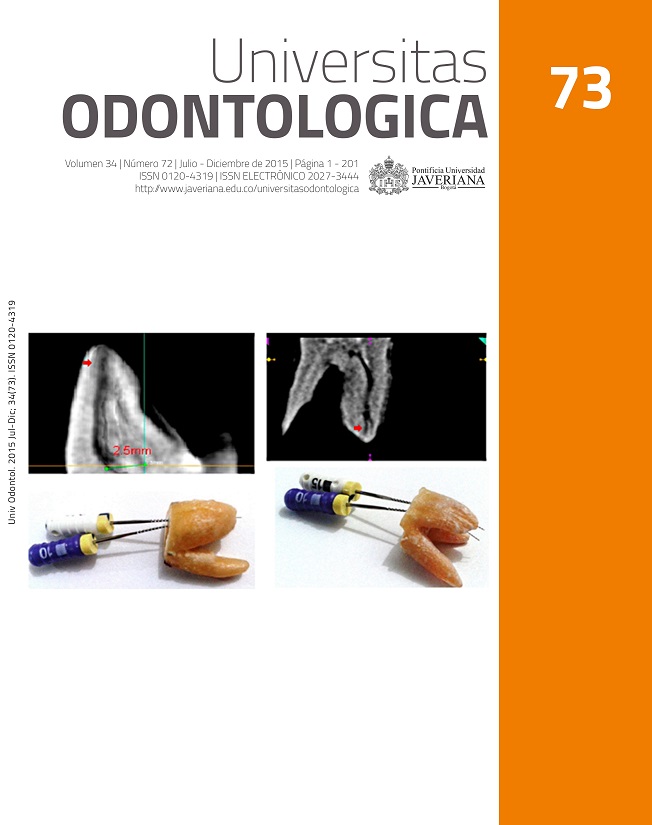Resumo
RESUMEN. Antecedentes: Es importante en la práctica clínica que los instrumentos rotatorios usados estén estériles para evitar infecciones cruzadas. Objetivo: Evaluar la efectividad del proceso de esterilización de las limas primarias WaveOne® con el propósito de fundamentar su reutilización. Métodos: Se evaluaron 50 limas primarias WaveOne®, 10 nuevas y 40 usadas en conductos mesovestibulares de molares con diagnóstico de periodontitis apical y necrosis pulpar. Las limas usadas se esterilizaron mediante la prueba de esterilidad establecida por la farmacopea 35 europea y japonesa. Resultados: Las 10 limas WaveOne® primarias, sin uso, no mostraron crecimiento de microorganismos. En el grupo 2, las 40 limas WaveOne® primarias usadas una vez y esterilizadas tampoco mostraron crecimiento de microorganismos. Conclusiones: El proceso de esterilización de las limas primarias WaveOne® fue satisfactorio. Además las limas primarias WaveOne®, como lo indica el fabricante, vienen estériles en su empaque.
ABSTRACT. Background: It is important that rotary instruments used in clinical practice are sterile to avoid cross-infection. Objective: To evaluate the effectiveness of the sterilization process of Primary WaveOne® files, in order to support their reutilization. Methods: The sample consisted of 50 Primary WaveOne® files, 10 new and 40 used to prepare mesio-vestibular root canals of molars with diagnosis of pulp necrosis or apical periodontitis. Files in group 2 were sterilized and tested through the protocol described at the European and Japanese Pharmacopoeia 35. Results: The 10 new Primary WaveOne® files did not show microorganism growth. The 40 sterilized files of group 2 did not show growth of microorganisms either. Conclusions: The process of file sterilization was effective. In addition, WaveOne® Primary files, as indicated by the manufacturer, come in sterile packaging.
Pinheiro E, Gomes B, Ferraz C, Sousa E, Teixeira F, Souza F. Microorganisms from canals of root-filled teeth with periapical lesions. Int Endod J. 2003; 36(1): 1-11.
Todd P, Whitney S, Walker S, Friedman S. Microbial contamination of endodontic files received from the manufacturer. J Endod. 2006; 32(7): 649-51.
Linsuwanont P, Parashos P, Messer H. Cleaning of rotary nickel-titanium endodontic instruments. Int Endod J. 2001; 37: 19-28.
Johnson M, Primack P, Loushine R, Craft D. Cleaning of endodontic files, part I: the effect of bioburden on the sterilization of endodontic files. J Endod. 1997; 23(1): 32-4.
Parashos P, Linsuwanont P, Messer HH. A cleaning protocol for rotary nickel-titanium endodontic instruments. Aust Dent J. 2004; 49(1): 20-7.
Aasim S, Mellor A. The effect of pre-soaking and time in the ultrasonic cleaner on the cleanliness of sterilized endodontic files. Int Endod J. 2006; 39: 143-9.
Dentsply India. Products. Weybridge, UK: Dentsply IH Ltd.; 2014. Consultado: marzo 2014. Disponible en línea en: http://dentsply.co.in/catalog/wave%E2%80%A2one%E2%84%A2-file.
Berutti E, Chiandussi G, Paolino D. Canal shaping with WaveOne primary reciprocating files and Protaper system: a comparative study. J Endod. 2012, 38(4): 505-9.
Wave One- Endodoncia- Sistema reciprocante de lima única. Dental Tv Web; 2010. Consultado: marzo 2014. Disponible en línea en: http://www.dentaltvweb.com/producto/wave-one-endodoncia-sistema-reciprocante-de-lima-unica.
Berutti E. Root Canal Anatomy preservation of WaveOne reciprocating files with or without glide path. J Endod. 2012; 38(1): 101-4.
Berutti E, Chiandussi G. Effect of canal length and curvature on working length alteration with WaveOne reciprocating files. J Endod. 2011; 37(12): 1687-90.
The U.S. Pharmacopeial Convention. USP 35-NF 30. United States Pharmacopeial and the National Formulary. 2012. Disponible en línea en: http://www.usp.org/.
Parirok H, Asgary S, Eghbal MJ. An energy dispersive X-ray analysis and SEM study of debris remaining on endodontic instruments after ultrasonic cleaning and autoclave sterilization. Aust Dent J. 2005; 31(2): 53-8.
Smith A, Lettersa S, Langeb A, Perrettc D, McHugha S, Bagga J. Residual protein levels on reprocessed dental instruments. J Hosp Infect. 2005; 61: 237-41.
Sonntag D, Ove A. Effect of prion decontamination protocols on nickel-titanium rotary surfaces. J Endod. 2007; 33(4): 442-6.
Venkatasubramanian R, Jayanthi, Das U, Bhatnagar S. Comparison of the effectiveness of sterilizing endodontic files by 4 different methods: An in vitro study. J Indian Soc Pedod Prev Dent. 2010; 28(1): 2-5.
Van Eldik D, Zilm PS, Rogers AH, Marin PD. A SEM evaluation of debris removal from endodontic files after cleaning and steam sterilization procedures. Aust Dent J. 2004; 49(3): 128-35.
Bourvis N, Boelle P, Cesbron J, Valleron A. Risk assessment of transmission of sporadic Creutzfeldt-Jakob disease in endodontic practice in absence of adequate prion inactivation. PLoS ONE. 2007; 12: 13-30.
Lemmer K, Mielke K, Georg P, Beekes M. Decontamination of surgical instruments from prion proteins: in vitro studies on the detachment, destabilization and degradation of PrPSc bound to steel surfaces. J Gen Virol. 2004; 85: 3805-16.
Este periódico científico está registrado sob a licença Creative Commons Atribuição 4.0 Internacional. Portanto, este trabalho pode ser reproduzido, distribuído e comunicado publicamente em formato digital, desde que os autores e a Pontifícia Universidade Javeriana sejam reconhecidos. Citar, adaptar, transformar, autoarquivar, republicar e criar novas obras a partir do material é permitido para qualquer finalidade (mesmo comercial), desde que a autoria seja devidamente reconhecida, um link para o trabalho original seja fornecido e quaisquer alterações sejam indicadas. A Pontifícia Universidade Javeriana não detém os direitos sobre os trabalhos publicados, e o conteúdo é de exclusiva responsabilidade dos autores, que mantêm seus direitos morais, intelectuais, de privacidade e de publicidade.


